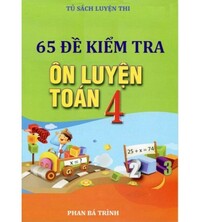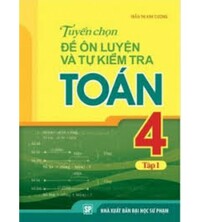Bài 105 : Luyện tập
Giải bài tập 1, 2, 3 trang 24, 25 VBT toán 4 bài 105 : Luyện tập với lời giải chi tiết và cách giải nhanh, ngắn nhất
Bài 1
Quy đồng mẫu số hai phân số :
a) \(\displaystyle{5 \over 8}\) và \(\displaystyle{8 \over 5}\) b) \(\displaystyle{7 \over 9}\) và \(\displaystyle{{19} \over {45}}\)
c) \(\displaystyle{8 \over {11}}\) và \(\displaystyle{3 \over 4}\) d) \(\displaystyle{{17} \over {72}}\) và \(\displaystyle{5 \over {12}}\)
Phương pháp giải:
Khi quy đồng mẫu số hai phân số có thể làm như sau:
- Lấy tử số và mẫu số của phân số thứ nhất nhân với mẫu số của phân số thứ hai.
- Lấy tử số và mẫu số của phân số thứ hai nhân với mẫu số của phân số thứ nhất.
Lời giải chi tiết:
a) Ta có: \(\displaystyle{5 \over 8} = {{5 \times 5} \over {8 \times 5}} = {{25} \over {40}} \;;\) \(\displaystyle{8 \over 5} = {{8 \times 8} \over {5 \times 8}} = {{64} \over {40}}.\)
Vậy quy đồng mẫu số của \(\displaystyle{5 \over 8}\) và \(\displaystyle{8 \over 5}\) được \(\displaystyle{{25} \over {40}}\) và \(\displaystyle{{64} \over {40}}.\)
b) Ta có: \(\displaystyle{7 \over 9} = {{7 \times 5} \over {9 \times 5}} = {{35} \over {45}}.\)
Vậy quy đồng mẫu số của \(\displaystyle{7 \over 9}\) và \(\displaystyle{{19} \over {45}}\) được \(\displaystyle{{35} \over {45}}\) và \(\displaystyle{{19} \over {45}}\)
c) Ta có:
\(\displaystyle {8 \over {11}} = {{8 \times 4} \over {11 \times 4}} = {{32} \over {44}} \;;\) \(\displaystyle{3 \over 4} = {{3 \times 11} \over {4 \times 11}} = {{33} \over {44}}. \)
Vậy quy đồng mẫu số của \(\displaystyle{8 \over {11}}\) và \(\displaystyle{3 \over 4}\) được \(\displaystyle{{32} \over {44}}\) và \(\displaystyle{{33} \over {44}}.\)
d) Ta có \(\displaystyle{5 \over {12}} = {{5 \times 6} \over {12 \times 6}} = {{30} \over {72}}.\)
Vậy quy đồng mẫu số của \(\displaystyle{{17} \over {72}}\) và \(\displaystyle{5 \over {12}}\) được \(\displaystyle{{17} \over {72}}\) và \(\displaystyle{{30} \over {72}}.\)
Bài 2
Quy đồng mẫu số các phân số (theo mẫu):
Mẫu: Quy đồng mẫu số các phân số \(\displaystyle{2 \over 3};{1 \over 4}\) và \(\displaystyle{3 \over 5}.\)
\(\displaystyle{2 \over 3} = {{2 \times 4 \times 5} \over {3 \times 4 \times 5}} = {{40} \over {60}};\) \(\displaystyle{1 \over 4} = {{1 \times 3 \times 5} \over {4 \times 3 \times 5}} = {{15} \over {60}} ;\)
\(\displaystyle{3 \over 5} = {{3 \times 3 \times 4} \over {5 \times 3 \times 4}} = {{36} \over {40}}\)
Vậy : Quy đồng mẫu số của \(\displaystyle{2 \over 3};{1 \over 4}\) và \(\displaystyle{3 \over 5}\) được \(\displaystyle{{40} \over {60}};{{15} \over {60}};{{36} \over {60}}.\)
a) \(\displaystyle{1 \over 2};{2 \over 5}\) và \(\displaystyle{4 \over 7}\)
b) \(\displaystyle{3 \over 2};{2 \over 3}\) và \(\displaystyle{5 \over 7}\)
Phương pháp giải:
Khi quy đồng mẫu số ba phân số có thể làm như sau:
- Lấy tử số và mẫu số của phân số thứ nhất nhân với tích của mẫu số của phân số thứ hai và mẫu số của phân số thứ ba.
- Lấy tử số và mẫu số của phân số thứ hai nhân với tích của mẫu số của phân số thứ nhất và mẫu số của phân số thứ ba.
- Lấy tử số và mẫu số của phân số thứ ba nhân với tích của mẫu số của phân số thứ nhất và mẫu số của phân số thứ hai.
Lời giải chi tiết:
a) Ta có:
\(\displaystyle{1 \over 2} = {{1 \times 5 \times 7} \over {2 \times 5 \times 7}} = {{35} \over {70}};\) \(\displaystyle {4 \over 7} = {{4 \times 2 \times 5} \over {7 \times 2 \times 5}} = {{40} \over {70}}\)
\(\displaystyle{2 \over 5} = {{2 \times 2 \times 7} \over {5 \times 2 \times 7}} = {{28} \over {70}}\)
Vậy quy đồng mẫu số của \(\displaystyle{1 \over 2};{2 \over 5}\) và \(\displaystyle{4 \over 7}\) được \(\displaystyle{{35} \over {70}};{{28} \over {70}};{{40} \over {70}}.\)
b) Ta có:
\(\displaystyle {3 \over 2} = {{3 \times 3 \times 7} \over {2 \times 3 \times 7}} = {{63} \over {42}}; \) \(\displaystyle {5 \over 7} = {{5 \times 2 \times 3} \over {7 \times 2 \times 3}} = {{30} \over {42}}; \)
\(\displaystyle {2 \over 3} = {{2 \times 2 \times 7} \over {3 \times 2 \times 7}} = {{28} \over {42}} \)
Vậy quy đồng mẫu của \(\displaystyle{3 \over 2};{2 \over 3}\) và \(\displaystyle{5 \over 7}\) được \(\displaystyle{{63} \over {42}};{{28} \over {42}}\) và \(\displaystyle{{30} \over {42}}.\)
Bài 3
Tính theo mẫu:
Mẫu: \( \displaystyle{{5 \times 6 \times 7\times 9} \over {12 \times 7 \times 27}} = {{5 \times \not{6} \times \not{7}\times \not{9}} \over {\not{6} \times 2 \times \not{7} \times \not{9} \times 3}} \) \( \displaystyle = {5 \over {6}}.\)
a) \(\displaystyle {{3 \times 4 \times 7} \over {12 \times 8 \times 9}}\)
b) \(\displaystyle {{4 \times 5 \times 6} \over {12 \times 10 \times 8}}\)
c) \(\displaystyle {{5 \times 6 \times 7} \over {12 \times 14 \times 15}}\)
Phương pháp giải:
Phân tích tử số và mẫu số thành tích của các thừa số, sau đó lần lượt chia nhẩm tích ở tử số và tích ở mẫu số cho các thừa số chung.
Lời giải chi tiết:
a) \(\displaystyle {{3 \times 4 \times 7} \over {12 \times 8 \times 9}} \)\(\displaystyle= \dfrac{\not{3}\times \not{4}\times 7} {\not{3}\times \not{4} \times 8 \times 9}\)\(=\dfrac{7}{72}\)
b) \(\displaystyle {{4 \times 5 \times 6} \over {12 \times 10 \times 8}} \)\(\displaystyle= \dfrac{\not{4}\times \not{5}\times \not{6}} {\not{6}\times 2 \times \not{5}\times 2 \times \not{4} \times 2}\)\(=\dfrac{1}{8}\)
c) \(\displaystyle {{5 \times 6 \times 7} \over {12 \times 14 \times 15}}\)\(\displaystyle= \dfrac{\not{5}\times \not{6}\times \not{7}} {\not{6}\times 2 \times \not{7}\times 2 \times \not{5} \times 3}\)\(=\dfrac{1}{12}\)
Search google: "từ khóa + timdapan.com" Ví dụ: "Bài 105 : Luyện tập timdapan.com"







